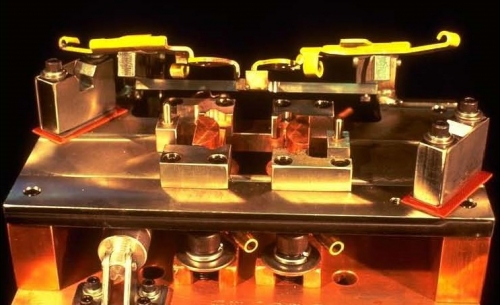
Water Cooling
Questions and Answers
The answer is no the base plates should not be hot. If they are the reason must be determined.
Tooling and fixtures are used in virtually all resistance welding operations to hold parts in place for welding. They must be kept clean of flash and debris and be safe for operators. Heat buildup should be minimized. If a fixture is heating up several possible reasons come to the forefront: Inductance, Insulation, weld flash and location.

BAD GOOD
This exhibits the part in the throat area but magnetic tooling in the throat causes the same problem. It absorbs energy and heats up during the welding process and forces the welder to work harder to make the desired spot weld.
Inductance is an electrical field induced in any magnetic material in or near the throat of an AC resistance welder. Insulated or not any magnetic material in or close to the throat of the AC machine can be affected. It will absorb energy and heat up. This includes the fixture itself or its components (bolts & nuts) or base plate. To prevent this, fixtures, base plates and other components should be fabricated from nonmagnetic materials (aluminum, copper, nonmagnetic stainless or insulators). Inductance is a common problem in the field. Many tool rooms are not aware of the problem (inductance). To check your tool, test your tool or components with a magnet to see if it is fabricated with magnetic material.
Insulation of the fixture is also necessary to prevent any current from flowing through the fixture and heating it up by resistance heating. This means insulating bolts, nuts, and washer with washers and sleeves as well as the mating surfaces underneath or between.
The other housekeeping issue is weld flash. A buildup of weld flash can lead to current flow on an otherwise insulated fixture. A stray current path of this sort can lead to heating of the fixture and loss of power at the welding operation.
The proximity (location) of the weld base to the welding should also be considered. Normally the electrodes handle the greatest heat and cooling functions. If the weld fixture base is too close it may come in contact with large amounts of heat and it may also need some form of heat dissipation. This could be a chill block or direct water cooling.

Weld Fixture Exhibiting Non Magnetic Stainless Tooling and Insulated Pins and Tools with Water Cooling
Reference: RWMA Manual Chapter 19
Barrel holders are the most common holder used for standard press welders. They came in several barrel diameters ranging from 5/8 – 1 ½”. The most popular size is 1 ¼” diameter. Standard lengths are 8 and 12”.
If one alters the weld time from the desired range and exceeds the extreme either too long or short you risk surface expulsion, electrode mushrooming, and excessive indentation. If weld times are short you risk small nuggets and low weld strength or no welds.
Improper weld current selection can cause problems during resistance welding. The problems normally show up in the form of expulsion, indentation, electrode sticking, mushrooming or low weld strength. There is an ideal current range for every resistance weld set up. This will produce good weld nuggets with little or no expulsion, modest indentation and minimal electrode wear or sticking. Whenever you push the extremes of the current in the weld window either high or low you risk problems.
If the weld equipment is not properly cooled especially the electrodes weld failure is likely to occur. Poor cooling at the electrodes can cause them to mushroom prematurely which reduces the current density at the weld face and the nugget size will reduce. Poor cooling can be caused by low flow, warm water, improperly located cooling tubes, clogged/restricted tubes and no flow.
Page 1 of 3
Have a Question?
Do you have a question that is not covered in our knowledgebase? Do you have questions regarding the above article? Click here to ask the professor.
